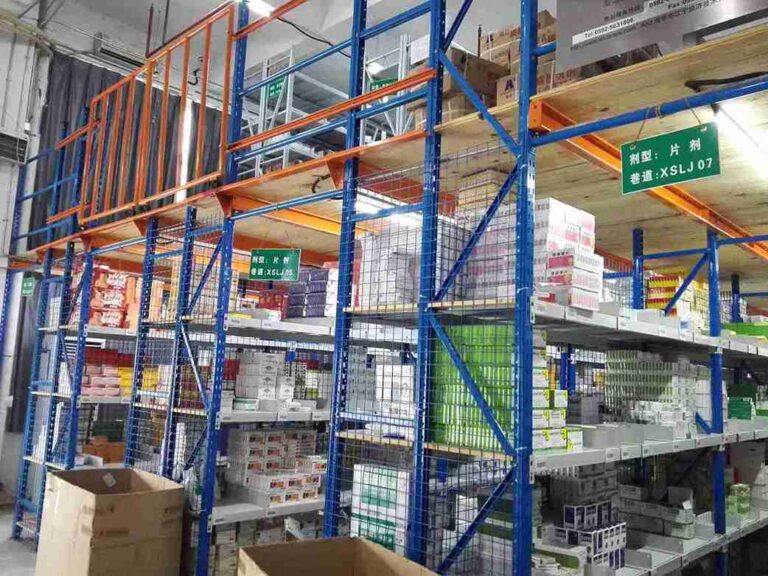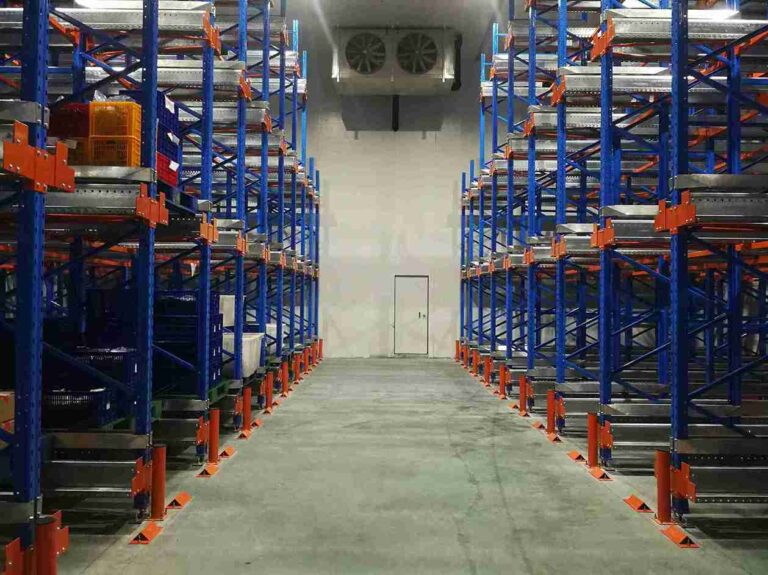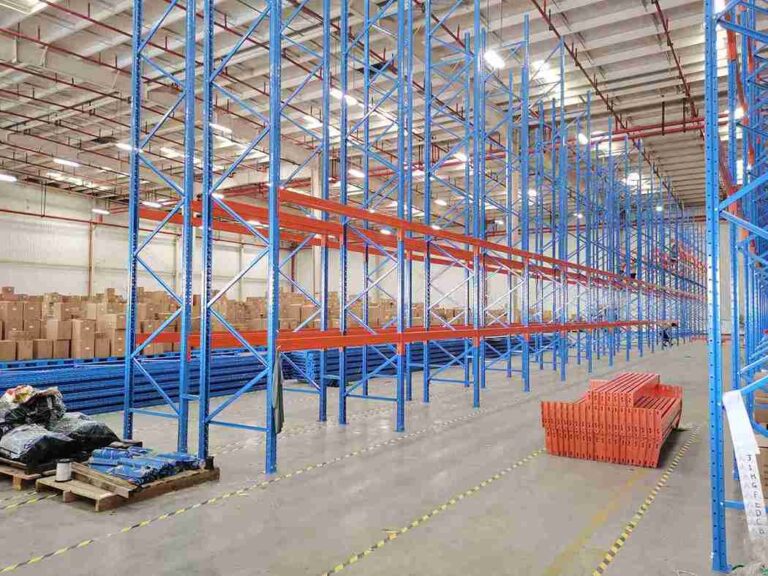📐 "First 50 Enterprise Queries Get Custom 3D Warehouse Design" Plan

The history of industrial storage is marked by a continuous drive for improvement. Traditional bolted shelving, while robust, represented an era where flexibility was often sacrificed for strength. The advent of boltless shelving systems marked a revolutionary turning point. These systems emerged from the need to respond faster to market dynamics.
In a world where inventory turnover rates are constantly accelerating and product lines change seasonally, the agility offered by boltless shelving systems became a critical competitive advantage. Unlike their predecessors, these boltless shelving systems were designed for the modern supply chain, where the ability to reconfigure a storage layout overnight can mean the difference between meeting a crucial order deadline or facing a stockout.
The engineering philosophy behind high-quality boltless shelving systems is not to replace strength with convenience, but to integrate the two into a single, cohesive solution. This makes modern boltless shelving systems a foundational technology for warehouses aiming to thrive in the 21st century.

Material Science in Boltless Shelving Systems: Beyond Basic Steel
Not all boltless shelving systems are created equal. The performance and longevity of a boltless shelving system are directly tied to the materials used in its construction. Leading manufacturers utilize high-tensile, cold-rolled steel for the upright frames and beams. This material is chosen for its superior strength-to-weight ratio and consistent structural properties. The process of cold-rolling strengthens the steel, allowing for the creation of thinner, yet stronger, components without adding unnecessary weight.
This is a critical consideration for the overall load capacity of the boltless shelving systems. Furthermore, the finish applied to these components is not merely cosmetic. A high-quality, electrostatically applied powder coat finish is essential for corrosion resistance. In environments with significant humidity or temperature fluctuations, such as in certain cold storage applications or manufacturing facilities, this protective layer ensures that the structural integrity of the boltless shelving systems remains uncompromised for years, protecting the owner’s investment.
Quantifying the ROI: A Detailed Cost-Benefit Analysis of Boltless Shelving Systems
Justifying a capital expenditure on new storage infrastructure requires a clear-eyed view of the return on investment. The financial argument for adopting boltless shelving systems is compelling and multi-faceted, extending far beyond the initial purchase price.
Direct Cost Savings: Labor, Time, and Tools
The most immediate financial benefit of boltless shelving systems is the dramatic reduction in installation labor. A traditional bolted system requires a team of installers with wrenches, torque wrenches, and potentially impact guns, working for extended periods. In contrast, a team erecting boltless shelving systems can often complete the same square footage in a fraction of the time. This is because the assembly of boltless shelving systems is a tool-free or minimal-tool process.
The patented locking mechanisms snap or hammer into place with swift, definitive actions. This efficiency translates into thousands of dollars saved on contracted installation labor or the redeployment of internal staff back to their revenue-generating tasks more quickly. The time-to-operational value of boltless shelving systems is a powerful, though often overlooked, financial metric.
Indirect Financial Advantages: Productivity and Error Reduction
The financial benefits of boltless shelving systems continue to accrue long after installation. The enhanced visibility and organization they provide lead to measurable gains in daily productivity. Pickers and warehouse staff spend less time searching for items and navigating congested aisles. Studies in operational efficiency have repeatedly shown that a well-organized warehouse with clear sight lines, a hallmark of well-planned boltless shelving systems, can increase order picking speeds by 15% or more.
This reduction in walk-and-search time directly lowers labor costs per order picked. Furthermore, the reduced physical and cognitive load on employees leads to fewer picking and put-away errors, which in turn minimizes the costly processes of returns, reshipments, and inventory reconciliation. The organizational clarity fostered by boltless shelving systems is a direct contributor to operational accuracy.
The Scalability Investment: Protecting Your Capital for the Future
Investing in a static storage system can be a liability in a growing business. The modular nature of boltless shelving systems makes them a uniquely scalable asset. A company can invest in a system that meets its current needs, with the absolute confidence that the same boltless shelving systems can be expanded, reconfigured, or even partially relocated as needs change.
This eliminates the risk of a storage system becoming obsolete. When a new product line is launched or a seasonal surge is anticipated, additional bays of boltless shelving systems can be integrated seamlessly with the existing setup. This scalability ensures that every dollar spent on boltless shelving systems is a long-term investment, protecting the business from the need for costly, wholesale replacements down the line.
Case in Point: Real-World Deployments of Boltless Shelving Systems
The theoretical advantages of boltless shelving systems are best understood through practical application. The following scenarios illustrate how different industries leverage the unique properties of boltless shelving systems to solve specific challenges.
Scenario A: E-Commerce Fulfillment Center Overhaul
A mid-sized e-commerce company was experiencing rapid growth but was constrained by its existing storage. Their old, fixed-height shelving led to massive wasted vertical space and inefficient picking paths. They deployed a comprehensive boltless shelving systems solution throughout their fulfillment center. The key was customization; the boltless shelving systems were configured with multiple shelf heights on the same upright frame, perfectly accommodating everything from small electronics to bulky apparel.
The wire mesh decking, a popular option for boltless shelving systems, improved air circulation for electronic components and provided superior visibility. The result was a 40% increase in storage capacity within the same footprint and a 20% reduction in average order picking time, directly attributable to the optimized layout enabled by the flexible boltless shelving systems.
Scenario B: Automotive Parts Distribution and MRO
A large automotive parts distributor managing a vast inventory of Maintenance, Repair, and Operations (MRO) items faced challenges with inventory control and space utilization. Their bulky, steel-sheet shelving made it difficult to see stock levels, leading to frequent over-ordering and stockouts.
They transitioned to heavy-duty boltless shelving systems with a combination of solid decking for small, loose items and wire decking for larger, identifiable components. The ability to easily add dividers, bins, and labeling systems directly onto the boltless shelving systems transformed their organization. Furthermore, when they needed to create a new section for a line of hybrid vehicle batteries, they were able to quickly reconfigure an existing aisle of boltless shelving systems to accommodate the heavier, larger items without any downtime, demonstrating the unparalleled adaptability of these systems.
The Synergy of Boltless Shelving Systems and Warehouse Technology
The true potential of boltless shelving systems is fully unlocked when they are integrated with the broader technological ecosystem of the modern warehouse. They serve as the perfect physical counterpart to digital management tools.
Boltless Shelving Systems as the Foundation for WMS Data Integrity
A Warehouse Management System (WMS) is only as good as the physical reality it represents. The clean, consistent, and highly organized structure of boltless shelving systems makes them an ideal platform for WMS integration. Each bay, shelf, and bin location within the boltless shelving systems can be assigned a unique alphanumeric code.
Because the system is so easily reconfigurable, the WMS database can be updated with new location maps almost instantly after a layout change, ensuring that data integrity is maintained. This seamless physical-digital interface means that directed put-away and picking commands from the WMS are executed with maximum efficiency within the boltless shelving systems environment.
Preparing for a Lights-Out Future: Boltless Shelving and Robotics
As automation becomes more accessible, the structural requirements for storage systems become more stringent. Robotic systems, such as Automated Guided Vehicles (AGVs) and Autonomous Mobile Robots (AMRs), require predictable and precise physical interfaces. The manufacturing tolerances and consistent dimensions of professional-grade boltless shelving systems make them an excellent choice for robotic integration.
The locking mechanisms ensure there is no bolt-head protrusion or loosening over time that could interfere with a robotic arm’s operation. Companies planning a phased approach to automation can confidently install boltless shelving systems today, knowing that the physical infrastructure will be fully compatible when they are ready to introduce robotics tomorrow. This positions boltless shelving systems as a future-proof investment in the automated warehouse.
Selecting the Right Partner for Your Boltless Shelving Systems
The decision to invest in boltless shelving systems is a significant one, and the choice of supplier is as critical as the choice of the system itself. The market is filled with options, but discerning buyers look for partners who offer more than just product.
The Critical Role of Expert Site Assessment and CAD Layout
A reputable provider of boltless shelving systems does not simply take an order. They initiate a consultative process beginning with a thorough site assessment. This involves measuring the facility’s exact dimensions, noting the location of columns, doors, sprinkler systems, and electrical panels. They will analyze your inventory profile, including weight, dimensions, and turnover velocity (ABC analysis). Using this data, they create detailed Computer-Aided Design (CAD) layouts.
These layouts are not just diagrams; they are optimized storage plans that maximize density, ensure efficient material flow, and comply with all safety regulations. This level of pre-sales service is a hallmark of a provider who is invested in the long-term success of your boltless shelving systems installation.
Ongoing Support, Maintenance, and Expansion Capabilities
The relationship with your boltless shelving systems provider should not end at delivery. A true partner offers ongoing support, including guidance on safe loading practices, reconfiguration advice, and access to a full range of compatible accessories. They should have the capacity to supply additional components years down the line, ensuring that your boltless shelving systems can grow with your business.
The availability of add-ons like solid shelving inserts, drawer systems, and mezzanine gates allows for continuous optimization of the original boltless shelving systems investment, adapting to evolving business needs without requiring a full system replacement.
Conclusion: Boltless Shelving Systems as a Strategic Imperative
In the final analysis, the question is no longer whether boltless shelving systems are a viable option, but whether any business seeking to optimize its storage operations can afford to ignore them. The combination of unparalleled flexibility, superior space utilization, rapid deployment, and seamless integration with modern technologies makes boltless shelving systems a cornerstone of efficient warehouse design. They represent a shift from viewing storage as a static, fixed cost to understanding it as a dynamic, strategic asset.
For organizations focused on maximizing storage density, accelerating operational efficiency, and building a resilient, adaptable supply chain, the implementation of a professionally designed and installed boltless shelving system is not just a purchase—it is a decisive step toward future-proofing their operational infrastructure and securing a lasting competitive advantage.
1. How does the resale or asset recovery value of boltless shelving systems compare to traditional racking?
The resale value and asset recovery potential for high-quality boltless shelving systems is typically significantly higher than for traditional bolted systems. The ease of disassembly and reconfiguration means that used boltless shelving systems are highly sought after in the secondary market. Their modular nature allows them to be broken down into smaller lots and resold to multiple buyers, whereas traditional systems are often more difficult to repurpose. This makes boltless shelving systems a more liquid and financially resilient asset.
2. Can boltless shelving systems be certified for seismic zones, and what does that process entail?
Yes, professional-grade boltless shelving systems can and should be engineered and certified for seismic compliance in relevant geographic zones. The process involves a Professional Engineer (PE) analyzing the specific configuration of the boltless shelving systems—including height, bay depth, and load placement—using standards from organizations like the Rack Manufacturers Institute (RMI) and applying local building code requirements.
The final design, including specific anchorage details, is then stamped and certified, ensuring the boltless shelving systems meet all safety regulations.
3. What are the fire safety considerations when using boltless shelving systems, particularly with wire mesh decking?
Wire mesh decking, a common feature in boltless shelving systems, is generally viewed favorably from a fire safety perspective. Unlike solid decking, which can act as a shelf that traps and accumulates combustible materials, wire mesh allows dust and debris to fall through, reducing fuel load.
It also minimizes obstructions, allowing sprinkler systems to function more effectively. However, a full fire safety assessment should always consider the entire storage layout and the specific materials being stored.
4. For storing very small items, how do boltless shelving systems compare to bin shelving or drawer cabinets?
Boltless shelving systems excel as a flexible framework that can incorporate solutions for small parts. While a simple shelf in a boltless shelving system may not be ideal for tiny components, the system can be easily outfitted with a vast array of accessories.
Bin rails with small parts bins, shelf dividers, and even full-width drawer inserts can be integrated directly into the bays of the boltless shelving systems. This creates a hybrid solution that offers the macro-flexibility of adjustable shelving with the micro-organization of dedicated bin or drawer systems.
5. How does the procurement process for a large-scale boltless shelving system typically work?
The procurement process for a major boltless shelving systems project is collaborative. It typically begins with a consultation and data gathering phase, followed by the creation of a detailed CAD proposal and a formal quotation.
Once approved, the order is placed, and the manufacturer schedules production. Upon delivery, the client’s team can often handle the assembly, or the provider can manage the installation. The most critical step is the initial consultation and design, as a well-planned layout is the key to maximizing the return on investment from the boltless shelving systems.
Welcome to contact us, if you need warehouse rack CAD drawings. We can provide you with warehouse rack planning and design for free. Our email address is: jili@geelyracks.com




